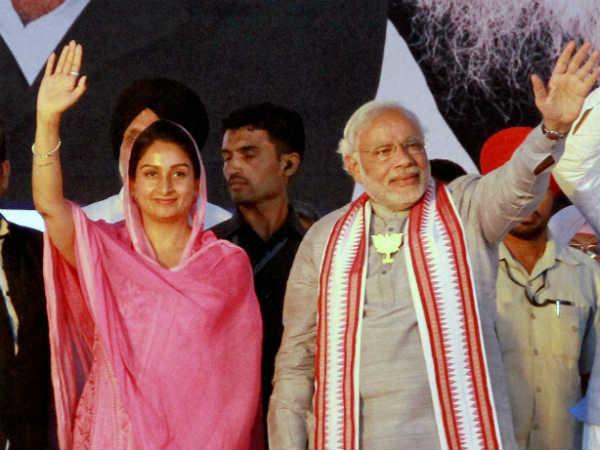Five times the amount of work has been done in the food industry in NDA’s four years, as compared to UPA’s sluggish growth in the sector during their rule.
Harsimrat Kaur Badal, Union Cabinet Minister of Food Processing, tweeted:
UPA sanctioned 42 Mega Food Parks from 2008-2014 but work only began in 2! NDA has operationalised 10 in 4 years and 5 are ready for inauguration too.
— Harsimrat Kaur Badal (@HarsimratBadal_) March 18, 2018
What Are Mega Food Parks?
With around 70 percent of the country’s population involved in farming, one-tenth of world’s arable land, one fifth of the world’s irrigated land, agriculture contributes to only 18 percent of the country’s gross domestic product (GDP). The reason for this situation is the absence of infrastructural support such as rural connectivity, storage and warehousing facilities to reduce high percentage of agricultural wastage.
Currently, India accounts for less than 1.5 per cent of international food trade, and the lack of processing facilities means that there is wastage of about 35 per cent of agricultural produce worth around $10 billion.
It is in this backdrop that food parks have become a necessity, to provide the crucial link between farmers and traders.
Mega Food Parks are an inclusive concept and a scheme of the Ministry of Food Processing of the Government of India, aimed at establishing a “direct linkage from farm to processing to consumer markets” through a network of collection centers and primary processing centers. Its purpose is to exponentially increase the processing capacity of perishables and to increase India’s share in global food trade.
Highlights:
– Government provides grants up to Rs 50 crores for each food park to a consortium of companies.
– 42 food processing units are expected to be established.
– Collective investment of companies is expected to be of at least 250 crores.
– A turnover of 400-500 crore and employment generation of at least 30,000 from each mega food park is expected.
Benefits:
– Direct as well as indirect employment generation in rural areas.
– Exposing farmers to more systematic, market driven and profitable farming activities.
– Generation of additional income for the farmers.
– Reduction in post-harvest losses.
– Maintenance of value chain from the farm to the market.
Congress’ Failure and Blame Game:
From 2008 to 2014, UPA sanctioned 42 Mega Food Parks but started working on only 2 of them. NDA has operationalized 10 in the last 4 years, while 5 others are ready for inauguration.
Everyone knows what Congress has achieved in Amethi despite the constituency sending Gandhi family members to parliament, and how it continues to keep this constituency under-developed. According to the then Union HRD minister Smriti Irani in 2015, Congress didn’t provide land and the required gas to Amethi between 2010 and 2014. She had then accused Rahul Gandhi of caring for business houses more than the local farmers. Food Processing Minister Harsimrat Kaur said the company promoting Amethi’s food park had expressed its inability to pursue the project in the absence of natural gas, which was denied to it by the government in December 2012.
Kaur said, in view of inordinate delay by the promoter company in meeting the “pre-conditions for final approval, the in-principle approval accorded to the project by the Ministry was cancelled”.
In his May 2015, in a reply to Home Minister Rajnath Singh, who had forwarded Badal’s explanatory letter, Rahul Gandhi said, “I am deeply dismayed to read the reasons and chronology of events contained in Badal’s letter. The contents of Badal’s letter confirm in writing what I had suspected all along — that cancellation of the mega food park was on account of politics of revenge aimed at punishing the farmers of UP, particularly Amethi.”
In a desperate attempt to hide their own failure, the Congress had then created a ruckus in parliament and forced an adjournment of the house over food processing minister Harsimrat Kaur Badal’s repeated statements on the matter. Congress floor leader Mallikarjun Kharge in his speech alleged that the country was witnessing a “deliberate scuttling of many UPA projects”.
Union Minister of State in the Ministry of Food Processing Industries, Niranjan Jyoti said “Rahul Gandhi’s allegation that the NDA government is discriminating against Amethi is not correct. The proposed food park did not have the requisite land, without which it is not possible to accord permission for a food park. If a project meets the parameter of the ministry, the ministry has no problem in sanctioning projects and we do not discriminate on the ground of place or region, for we want development of all.”
Growth So Far:
Mega food parks typically consist of supply chain infrastructure including collection centers, primary processing centers, central processing centers, cold chains and around 30-35 fully developed plots for entrepreneurs to set up food processing units.
The government has decided to set up 500 cold chains across the country to boost the food processing sector, which grew by more than 7 per cent last year.
A total of 138 integrated cold chain projects were sanctioned by the government till 2015. Out of this, 91 are operational.
The international food companies are showing keen interest to invest in food processing sector after the Centre allowed 100 per cent FDI in marketing of food products manufactured and produced in India.
